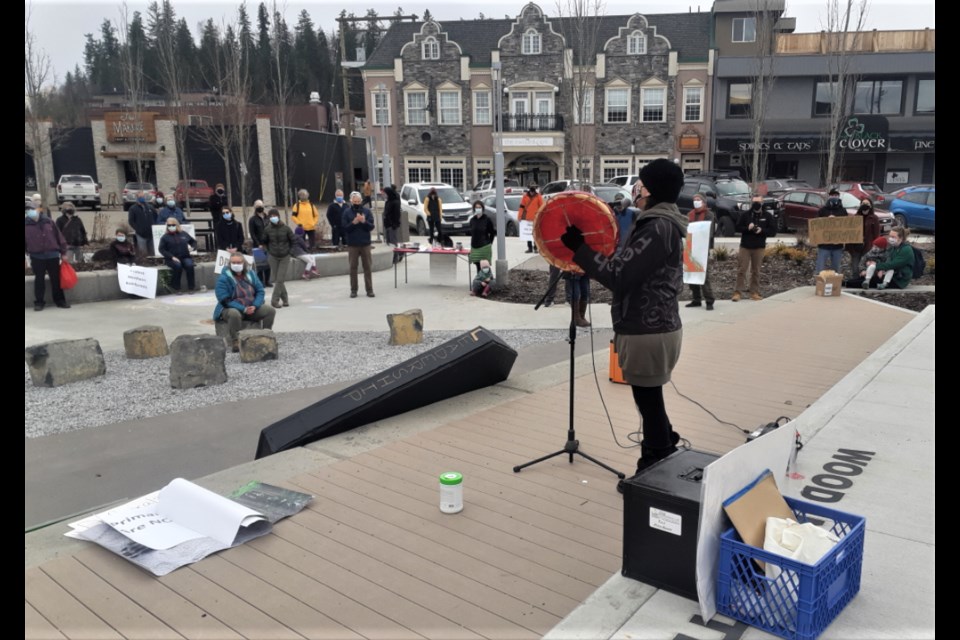Old growth forests, as they exist in British Columbia, are an increasingly-rare species-preserving resource living under the threat of our current forest harvest practices and once they’re gone there’s no going back.
Those big trees and their ability to pull carbon out of the atmosphere and the shelter they provide to unique lifeforms will be lost forever, according to UNBC plant ecologist Art Fredeen, who expressed his concerns at the Rebellion of Forests protest next to the Wood Innovation & Design Centre Friday afternoon.
“In Canada because we’re a young country, the old-growth forest is almost always primary forest that’s never been touched, it’s not secondary growth that we’re trying to get to, but the problem is our forests don’t grow that quickly here in the Interior,” said Fredeen. “So we’re still going after primary forest and there’s so little left. In the really productive impressive big forests, there’s only three per cent of that left now in B.C.
“Let’s get away from this thought old-growth primary forest is renewable - it is a non-renewable resource. When indigenous people lived on this land the pressures on that primary forest were very low, but we’ve exploded the population and we have mechanized forestry now that can level forests in the snap of a finger. It’s a different time now. We used to live in harmony with the land but the way our system is set up, we can’t. So we have to stop logging that old forest. There’s so little left, leave it alone.”
Friday’s event was organized by Conservation North to try to spur the B.C. NDP government to live up to its campaign promises before the fall election and follow through on recommendations of an independent study to review the province’s old-growth forest practices.
The report - A New Future for Old Forests - suggests the government engage with indigenous leaders and organizations to work together with labour, industry and environmental groups to develop strategies and engage in forest management practices that will conserve biodiversity.
Released in September, the document also calls for immediate development deferral of nine old growth areas encompassing 353,000 hectares of B.C. forest. But logging continues unabated in a spine of old-growth spruce, cedar and hemlock in the temperate inland rainforest areas along the Rocky Mountain trench east of Prince George, and that concerns Conservation North director Michelle Connolly.
“It’s been six months since John Horgan made a commitment during the election to implement the recommendations of his own old growth panel, it’s a really readable report that has what they want to do and how to implement it and he hasn’t really paid attention to it,” said Connolly.
“They announced some feeble deferral areas last year and none of those deferral areas were up here in the central interior and the north. Most of our high-productivity old growth, especially our old-growth spruce forests here, are in big trouble and we need deferrals now.
“We’re aware of some of the dynamics and some of the pressure (Horgan) gets from industry and we don’t think that’s appropriate. We think the government needs to do the right thing by the people of B.C. and doing that means protecting some last pieces of our natural heritage, which are our old-growth forests.”
Connolly says the expertise is available locally to steer harvesting practices away from old growth and adapt to making forest products with smaller-diameter wood, as European countries such as Germany have already been forced to do after their oldest trees were completely logged.
“We’re not sure why they’re not making that happen a lot faster and transitioning away from old growth because it’s just not necessary anymore,” Connolly said. “Everybody in the north understands why natural forests are so important. They regulate stream temperatures, they make sure fish habitat is OK, they’re habitat for the things we hunt and for endangered species. Marten, fisher, goshawk are all in trouble because of the loss of old growth.”
About 150 people attending the protest.
Retired forester Robert Norwell says the public appetite for protection of old growth areas is continually increasing and people want the government to take action to ensure those increasingly rare trees will be preserved. He projects that by 2055, if the current rate of harvesting trees 140 years or older remains unchanged, there will be no old growth left in the Prince George timber supply area.
“There’s a feeling that old growth is being utilized and we’re losing a lot of benefits from our environment and it’s not just a feeling, the industry is using up the very last of our 250-year-and-older trees in preference to anything else, and also the high sites (trees of 10 metres and taller) are being taken as well,” said Norwell.
“What’s so tasty about old growth is it’s got the most value for our forest industry and it’s going to take a lot of leadership in our government to say to our forest industry that there are benefits besides the money that we can get for our economy. The environmental and ecological benefits far outweigh the economic benefits.”



